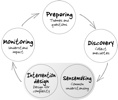Blog
Subscribe
Join over 5,000 people who receive the Anecdotally newsletter—and receive our free ebook Character Trumps Credentials.
Categories
- Anecdotes
- Business storytelling
- Collaboration
- Communication
- Corporate Storytelling
- Culture
- Decision-making
- Employee Engagement
- Events
- Fun
- Insight
- Leadership Posts
- News
- Podcast
- Selling
- Strategy
Archives
- April 2024
- March 2024
- December 2023
- November 2023
- October 2023
- September 2023
- August 2023
- July 2023
- June 2023
- May 2023
Years
Narrative or story-based approach to employee engagement
Late last year, a company approached us on the topic of employee engagement. They’d received the results of their biannual engagement survey and, as with previous years, realised that the data pointed them to strengths and potential weaknesses but didn’t help understand what was really going on, or what to do about it. The data might show that 63% of staff agreed or strongly agreed with the statement ‘I am proud to work for this company’ and this might be down 6% from the previous survey. On its own however, the data doesn’t help with the question “what does this mean and what should be done? ”
They’d received the results of their biannual engagement survey and, as with previous years, realised that the data pointed them to strengths and potential weaknesses but didn’t help understand what was really going on, or what to do about it. The data might show that 63% of staff agreed or strongly agreed with the statement ‘I am proud to work for this company’ and this might be down 6% from the previous survey. On its own however, the data doesn’t help with the question “what does this mean and what should be done? ”
Narrative approaches are excellent for exploring these sorts of issues and helping organisations find out what is really going on, and what actions they can take to reinforce things that are going well, and improving things that need work. The survey data is vital ‘targeting information’ but on its own it is an insufficient basis for planning. Thus, exploring employee engagement is a natural marriage of traditional approaches such as surveys and the emerging practice of narrative.
Our approach to staff engagement looks like this:
- Employee engagement surveys often focus on areas such as: do people say positive or negative things about the organisation; their intent to stay with the company; and whether they are motivated to strive to do the best they can for the company. In preparing for the narrative project, the survey data is examined to identify the themes to be explored, the geographic or structural areas to focus on and the people to involve in the project. Key stakeholders are also asked for their views on the survey results and the things that are of most concern or surprise to them.
- We use anecdote circles during the ‘discovery phase’ of these projects to collect a large number of examples (anecdotes) of how staff at all levels in the organisation experience issues on a day-to-day basis. The anecdote circles are an intervention in themselves as they get groups of people sharing their experiences; people value the opportunity to be listened to and participants learn from each other about how things get done. Recently, during an anecdote circle, a participant related how he received a call early one morning from his manager asking if he’d heard about the severe storm warning for his area (he hadn’t). The manager was worried about him driving to work in the storm and requested that he work from home that day. The guy telling the story was really impressed by the phone call. This was a great example of how small actions can really help build employee engagement.
- In the sensemaking phase a significant and diverse groups of influencers are exposed to a cross-section of the collected anecdotes and are facilitated to engage in dialogue with each other to identify issues and themes regarding the current situation. The idea of sensemaking is to develop a rich and common understanding among these influencers of the current situation and its history. Exposure to the anecdotes provides participants with insights into what really goes on in the organisation; this can be quite confronting at times. Nonetheless, sensemaking is a vital step as the individual and collective understand it provides is the springboard for deciding what action to take. The sensemaking workshop takes between 4 hours to a full day and one of its valuable side effects is that individuals will often change (deliberately or sub-consciously) their behaviour back in the workplace as a result of the new understanding they’ve developed. This is an important step as one of the key actions to improve staff engagement is to ‘stop doing things that piss staff off.’
- Complex problems cannot be ‘solved’ in any traditional sense and the way to make progress is to try things and see what happens. Using the deep understanding developed during the sensemaking phase, we involve the influencers in identifying the actions that can be taken to move the situation in a desirable direction. Our approach to this stage (which we call initiative design) is strongly influenced by the characteristics of complex problems meaning we encourage the organisation to identify lots of small scale actions that can be implemented at an individual or team level, based on the knowledge that with complex problems, little things can make a big difference. We also encourage the development of a ‘continual improvement process’ that aims to get these changes embedded in the fabric of the organisation.
- The final stage is to monitor what happens as a result of the actions taken – reinforcing the patterns that are beneficial and disrupting the ones that aren’t. This is achieved through the embedding process developed during sensemaking and by using techniques such as most significant change. A planned monitoring regime is important as it helps detect changes – it also works as an incentive to implement the actions identified during intervention design
Since the initial approach, several other unrelated opportunities have emerged to work with companies to explore their employee engagement outcomes. Our extensive work in leadership/management development also has a strong link to employee engagement (as the main roles of a manager can be summarised as ‘driving performance’ and ‘building engagement’). It looks like employee engagement is a growing area for us to apply narrative approaches.
 About Mark Schenk
About Mark Schenk
Mark works globally with senior leadership teams to improve their ability to communicate clearly and memorably. He has been a Director of Anecdote since 2004 and helped the company grow into one of the world’s leading business storytelling consultancies. Connect with Mark on:
Comments
Comments are closed.
Why an initiative? Why not continuous?
This sentence “the main roles of a manager can be summarised as ‘driving performance’ and ‘building engagement’ – for me is the key to this article.
Too often management is focused on ‘tasks and activities’ where to really drive performance and build engagement, managers need to become better man-managers or mentors and connect the hearts and minds of employees with the values and vision of the company.
Your approach seems an interesting one, and one which would certainly tap into to that emotional connection.
Richard
Hi Mark, sounds like your firm is involved with some interesting narrative work in the employee engagement arena. I would also agree with your comment that this is a growing area of interest for firms- since competitive advantage is increasingly tied to the intellectual capital in the collective employee conscience.
As your narrative work evolves, quantitative approaches that measure behavioural outcomes like increased discretionary efforts and reduced turnover might also be useful in communicating the importance of a focus on employee engagement to your leadership group.
Best wishes
Dave
Yes, continuous is the better word in this context. We use the term ‘initiative’ as a deliberate attempt to get people out of ‘project’ and ‘task’ thinking. Our experience is that people love to come up with big things that other people should do and find it quite difficult to identify small things that they (and others) can do themselves. This is part of our effort to generate behaviour change rather than extra things to go on a to-do list.
Hi Richard
I like the simplicity of the ‘drive performance and build engagement’ construct. The challenge for managers is in striking the right balance. Of course this is made infinitely easier by managers thinking of their people as people rather than as objects (staff, resources etc). This helps managers do just about everything in an engaging way that connects with hearts and minds.
Hi Dave,
Do you have any thoughts on quantitative measures/indicators for increased discretionary efforts?